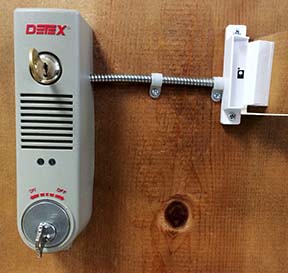 Facilities use exit alarms for a variety of reasons.
Facilities use exit alarms for a variety of reasons.
Is food from your restaurant somehow disappearing out the back door? An exit alarm can fix that. What about an unwanted visitor sneaking in after hours? An exit alarm can solve that problem, too. So for whatever reason you’re installing an exit alarm, you need to know your options.
That’s where I come in. Working at LockNet, I happen to know a thing or two about exit alarms, and I’m more than happy to shed a little light on the subject.
You have a couple of options: Alarmed exit devices and exit door alarms. While they sound similar, they do have their differences.
Alarmed Exit Devices
Alarmed exit devices can only be deactivated by a key and only before the door is opened. The act of the door opening is what causes the alarm to sound, and once the alarm goes off, the only way to shut the alarm off is with the use of that handy key I just mentioned. I would like to tell you that I learned that handy bit of info while working at LockNet, but no. Let’s just say there was one time I tried to leave through an alarmed exit device, but instead I set off alarms throughout an entire building. Try as I might to deactivate the darn thing by simply shutting the door, it just wouldn’t work. The facility manager had to come and shut the alarm off with a key. And no, that wasn’t embarrassing at all, thanks for asking.
Alarmed exit devices are more expensive than exit door alarms, and if you’re installing one, it’s important to make sure the unit is weatherized. Typically, alarmed exit devices are installed on back-of-house doors, and those doors are often propped open for deliveries. If it’s raining, the water can damage the alarm, resulting in an expensive (not to mention painful) replacement. However, the benefit of an alarmed exit device is there’s only one piece of hardware to install. Plus, there aren’t any additional wires that can be tampered with or door sensors that can cause false alarms.
Exit Door Alarms
An exit door alarm doesn’t have to be installed on the door itself. It can instead be installed on the wall next to the door. It operates using contact sensors; there is a magnetic field between the contact sensors, and if that field is broken, the alarm will sound. Once the alarm sounds it can only be deactivated by a key.
Exit Door Alarms are much less expensive than alarmed exit devices, and they can be installed on any existing door. But there are a few things to consider. If you decide to mount the alarm on the wall and not the door, you won’t have as clean a look: Exposed wires run from the device to the contact sensor, which is mounted to the frame. Plus, since they’re exposed, those wires can be easily tampered with. If someone pulls the wires free or cuts them, the alarms won’t sound. It’s for this exact reason that we recommend using an armored cable. With exit door alarms, you also have to be aware of potential door alignment issues. Since the field between the magnets is relatively small, even the smallest misalignment can cause the alarm to sound. But fear not– this can be corrected with a simple adjustment from a technician.
Thinking of installing an exit door alarm or alarmed exit device? Give us a shout. We’ll be more than happy to answer any questions you may have!
